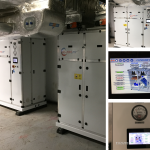As a « vital » organ of the hospital, the operating theater remains functional 24 hours a day: before deciding on its design, it is necessary to study the general logistics flow and its accessibility. In recent years, the modular concept has brought benefits to these two decision-making phases: discover them in this article.
The main objective of any prefabrication is to reduce the operations carried out on site: which makes possible to control the costs of realization while maintaining good quality of manufacture and result.
What are the advantages :
- Reduced time and budget control:
In the context of a classic prefabrication, bad weather and site hazards are still unmanageable constraints and prevent the time saving of operations. Modular prefabrication can minimize these delays and nuisances on construction sites by constructing main parts off-site, while benefiting from a tailor-made, sustainable and high-quality infrastructure. In average, the construction time of modular buildings is reduced by up to 70{01e3c5e93231d16e008ef94f2b1d6fd0127ff363a7cc717001d1444d838f865e} compared to other construction methods.
- Ability to cope with constraints on site:
Modular prefabrication becomes even more advantageous, if the site is difficult to access for a traditional long-term construction. - Reduced environmental impact:
This type of construction takes in account the total cost of the life cycle of the building (Life Cycle Cost). Modular prefabrication also makes possible to better control the costs of demolition or rehabilitation since it is possible to dismantle and reassemble the structures built.
What are the constraints and challenges?
For modular prefabrication, it is essential to define a main specifications before starting the construction. As a result, the upstream phase of projects is a crucial period. It is necessary that all the premises are drawn in detail and that the positioning of each element of the building was anticipated before considering its construction.
How many steps are taking place in the modular construction of a building?
Once this pre-project stage is completed, the production plans will be designed and validated by architects and project managers.
Subsequently, two phases are conducted in parallel: site preparation and module production.
The preparation of the site includes the possible demolition of existing facilities, earthworks, the construction of a foundation infrastructure, drainage and the routing of energy networks necessary for the operation of the modular building.
The production of modules, meanwhile, takes place in the workshops of the company. This superposition of work is at the origin of the significant time savings generated by the modular prefabrication. It allows to realize the structural work and the completion of the building while arranging the hospital site.
Then, the transport and installation phase of the modules takes place on the site.
Why are vertical air handling cabinets a benefit to this modular construction?
- Implantation possible from the pre-project phase.
ATA Medical offers cabinets and equipment made to measure according to the architectural constraints of the site: dimensions, position of the taken and blow inlets. - Vertical AHU follow the same logic of cost control and time.
By adapting to any architectural constraints, and not the other way around, Clinicair AHU can be installed closer to the area to be treated. This advantage reduces installation time, handling, but also their costs. - Adaptation to modular design for aesthetic rendering.
Installed closely to the area to be treated, such as an operating room or a technical corridor, the Clinicair are easily integrated in a wall design, even better if modular. Integral integration to the wall will avoid the problems of disinfection, and housing of bacteria. - Easier maintenance.
In addition to the aesthetic rendering, maintenance will be achieved more easily thanks to removable modular panels. Indeed, all our cabinets are accessible in frontage, but also on the side according to the chosen configuration. The two solutions are complementary here.
The choice of quality hygiene equipment, compliant with the Hospital standards.
In conclusion, long regarded as ephemeral building constructions or for low budget, the modular buildings bring today the quality expected at fixed and fixed prices.
The ATA equipment and pre-engineered modular operationtheatre not only solves the problem of infections but also facilitates speedy construction.
Source: http://www.architecture-hospitaliere.fr/wp-content/uploads/2017/05/p.108-111-Conception-Module-design-5D-Archipelago-AH-22-23.pdf



